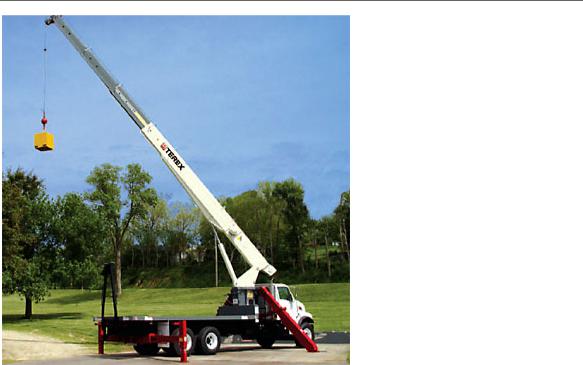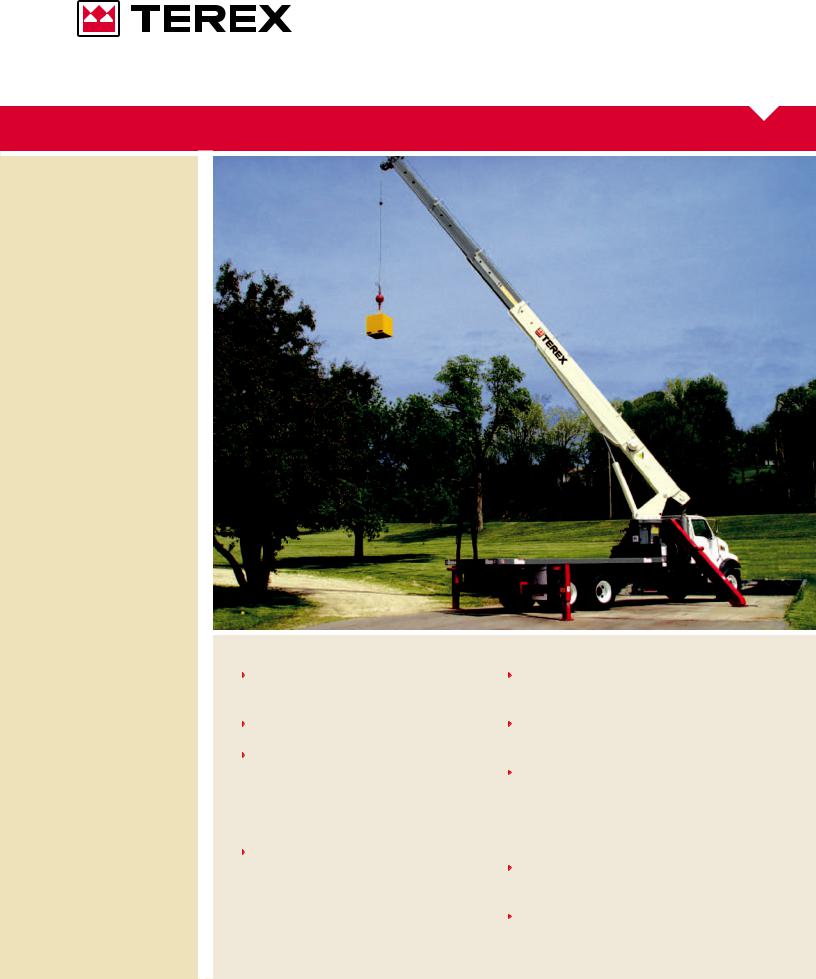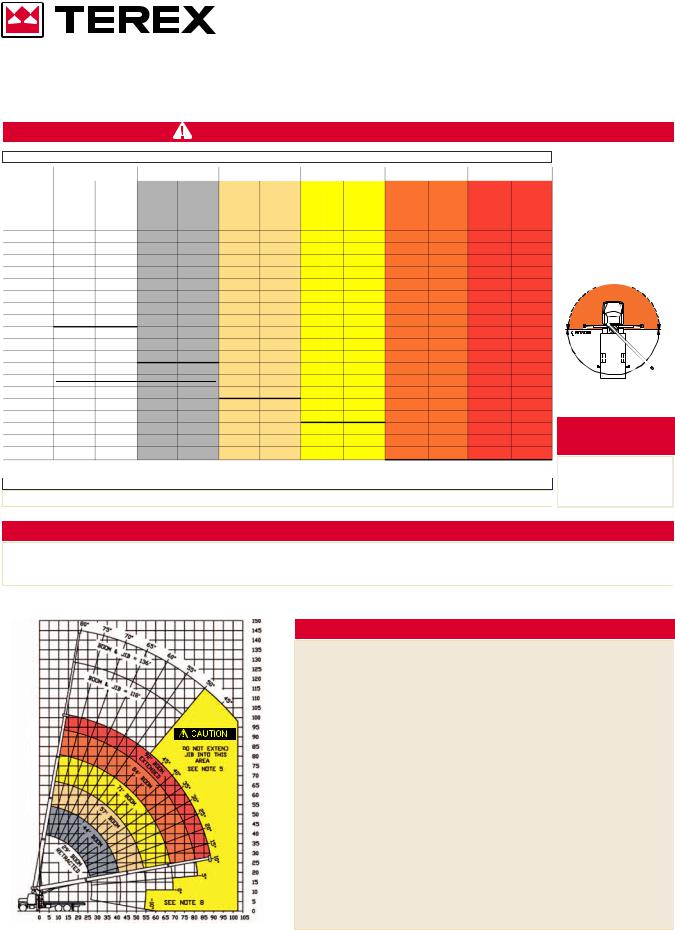Terex BT4792 User Manual

Terex BT4792 Boom Truck
Maximum Boom Length: |
92 ft (28.0 m) |
|
Number of Boom Sections: |
4 |
|
Available Jib Length: |
44 ft (13.41 m) |
|
Maximum Tip Height with Jib: |
144 ft (43.90 m) |
|
Swing 1 Rotation (sec): |
75 |
|
Boom up / down (sec): |
41/30 |
|
Boom Extension / Retract |
80/36 |
|
(sec): |
||
|
||
Chassis: |
2004 Sterling LT7501 |
|
Combined Axle Weight: |
60,000 Ib (27 210 kg) |
|
Front Axle Weight: |
20,000 Ib (9 067 kg) |
|
Rear Axle Weight: |
40,000 Ib (18 144 kg) |
|
Standard Engine Type: |
Caterpillar C-7 7.2L I-6 |
|
Standard Horsepower: |
300 hp @ 2,200 rpm |
|
Engine Transmissions: |
Eaton Fuller RT-8908LL |
|
Overall Length: |
38 ft (5.14 m) |
|
Overall Width: |
8 ft (2.44 m) |
|
Overall Height: |
13 ft 2 in (4.1 m) |
|
Weight Crane + Vehicle: |
41,732 lb (18 929 kg) |
|
(Assumes Std Chassis) |
||
|
||
Weight Crane Only: |
25,172 lb (11 418 kg) |

STINGER 4792 | Boom Truck Crane
<![endif]>BOOM TRUCK CRANE STINGER 4792
FEATURES |
|
|
47,000 Ib (21 319 |
aximum lifting |
|
capacity |
|
|
101’ (30.78 m) maximum |
ave height |
|
144’ (43.89 m) maximum |
ave height |
|
with 26-44’ (7.92-13.41 m) jib
 29-92’ (8.84-28.04 m) four-section full power fully synchronized boom
29-92’ (8.84-28.04 m) four-section full power fully synchronized boom
Exc |
olor coded boom and load |
charts |
|
 Easy-to-install optional ’ (7.92 m) one
Easy-to-install optional ’ (7.92 m) one
stag |
.92-13.41 m) two |
stag |
elescoping jib, man baskets or |
work platform increase job capacities
Electronic Load Moment Indicator and anti-two-block device standard
Externally located planetary rotation drive for easy accessibility for maintenance
2-speed planetary winch has 10,500 lb (4 703 kg) maximum permissible 1 part line, 37,000 Ib (16 783 kg) breaking strength, 186 ft/min (57 m/min) maximum line speed
Dual control station with direct mechanically controlled hydraulic system
90 gal (342 L) capacity hydraulic tank

BOOM TRUCK CRANE
STINGER 4792
BT MODEL
LOAD RATINGS |
|
CAUTION Do not use this specification sheet as a load rating chart. The format of data |
|
|
||||||||||
|
is not consistent with the machine chart and may be subject to change. |
|
|
|
||||||||||
|
|
|
|
|
|
|
|
|||||||
|
|
|
|
|
|
|
|
|
|
|||||
BOOM LENGTH |
|
|
|
Maximum Load Chart in pounds (lbs) with fully extended outrigger |
||||||||||
|
|
29 FT |
44 FT |
57 FT |
|
71 FT |
84 FT |
92 FT |
||||||
OPERATING |
|
LOADED |
LOAD |
LOADED |
LOAD |
LOADED |
LOAD |
LOADED |
LOAD |
LOADED |
LOAD |
LOADED |
LOAD |
|
|
BOOM |
RATING |
BOOM |
RATING |
BOOM |
RATING |
BOOM |
RATING |
BOOM |
RATING |
BOOM |
RATING |
||
RADIUS |
|
|||||||||||||
|
ANGLE |
(LB) |
ANGLE |
(LB) |
ANGLE |
(LB) |
ANGLE |
(LB) |
ANGLE |
(LB) |
ANGLE |
(LB) |
||
(FT) |
|
|||||||||||||
|
(DEG) |
|
(DEG) |
|
(DEG) |
|
|
(DEG) |
|
(DEG) |
|
(DEG) |
|
|
|
|
|
|
|
|
|
|
|
||||||
5 |
78 |
47,000* |
|
|
|
|
|
|
|
|
|
|
|
|
8 |
71 |
36,800* |
78 |
20,300* |
|
|
|
|
|
|
|
|
|
|
10 |
67 |
30,900* |
75 |
20,300* |
79 |
18,400* |
|
|
|
|
|
|
||
12 |
62 |
26,100* |
73 |
20,300* |
77 |
17, |
0* |
|
|
|
|
|
|
|
14 |
58 |
21,900* |
70 |
19,400* |
75 |
16,800* |
78 |
14,600* |
|
|
|
|
||
16 |
53 |
18,800* |
67 |
17,300* |
73 |
15,900* |
77 |
13,800* |
79 |
12,300* |
|
|
||
20 |
41 |
14,200* |
61 |
13,900* |
68 |
13,400* |
73 |
12,300* |
76 |
10,900* |
78 |
9,825* |
||
25 |
21 |
10,400* |
53 |
10,900* |
63 |
10,600* |
69 |
10,400* |
73 |
9,800* |
75 |
9,025* |
||
30 |
|
|
|
45 |
8,625* |
57 |
8,625* |
65 |
8,425* |
69 |
8,225* |
71 |
7,425* |
|
35 |
|
|
|
34 |
6,925* |
51 |
6,925* |
60 |
6,925* |
66 |
6,725* |
68 |
6,325* |
|
40 |
|
|
|
19 |
5,22 |
|
,625* |
56 |
5,625* |
62 |
5,625* |
65 |
5,425* |
|
45 |
|
|
|
|
|
36 |
4,625* |
50 |
4,625* |
58 |
4,625* |
61 |
4,625* |
|
50 |
|
|
|
|
|
26 |
3,725* |
45 |
3,725* |
53 |
3,725* |
57 |
3,725* |
|
|
NOTE: STRUCTURAL STRENGTH RATINGS IN |
|||||||||||||
55 |
|
1 |
1,225* |
38 |
3,025* |
|
3,025* |
|
3,025* |
|||||
60 |
|
CHART ARE INDICATED WIH AN ASTERISK * |
|
|
|
31 |
2,425* |
44 |
2,425* |
49 |
2,425* |
|||
|
|
|
|
|
|
|
|
|||||||
65 |
|
|
|
|
|
|
|
|
21 |
2,025* |
39 |
2,025* |
45 |
2,025* |
|
|
|
|
|
|
|
|
|||||||
70 |
|
|
|
|
|
|
|
|
|
|
32 |
1,525* |
40 |
1,525* |
75 |
|
|
|
|
|
|
|
|
|
|
25 |
1,22 |
|
|
80 |
|
|
|
|
|
|
|
|
|
|
14 |
825* |
28 |
825* |
|
|
|
|
|
|
|
|
|
|
|
|
|
||
STOWED JIB DEDUCTIONS (POUNDS) |
|
|
|
|
|
|
|
|
|
|||||
|
|
|
|
|
|
|
|
|
|
|
|
|
|
|
|
|
|
700 |
500 |
350 |
|
300 |
250 |
|
200 |
||||
|
|
|
|
|
|
|
|
|
|
|
|
|
|
|
AREA OF OPERATION
DO NOT OPERATE
IN SHADED AREA
WITHOUT
OPTIONAL FRONT
STABILIZER
Deductions from rate loads for load handling devices BT
Overhaul Ball |
175 lbs |
1 Sheave Load Block |
200 lbs |
2 Sheave Load Block |
250 lbs |
|
|
JIB CAPACITIES FOR ALL BOOM LENGTHS VERIFY OPERATIONAL MODE SETTING ON LMI DISPLAY BEFORE LIFTING WITH JIB
Loaded Boom Angle |
50º |
55º |
60º |
65º |
70º |
75º |
78º |
80º |
Retracted 26 ft Jib |
725 |
1,025 |
1,525 |
2,325 |
3,225 |
4,325 |
4,925 |
5,325 |
Extended 44 ft Jib |
425 |
725 |
1,125 |
1,525 |
2,02 |
,525 |
2,825 |
3,125 |
|
|
|
|
|
|
|
|
|
RANGE DIAGRAM (29 - 92 FT BOOM)
<![endif]>CENTERLINE OF ROTATION
<![endif]>SHEAVE HEIGHT - FEET
GENERAL NOTES
1. The operator must read and understand the Owner's Manual before operating this crane.
2. Positioning or operation of crane beyond areas shown on this chart is not intended or appro except where specified in Owner's Manual.
3.Loaded boom angles at specified boom lengths give only an approximation of the operating radius. The boom angle before loading should be greater to account for deflections. Do not exceed the operating radius for rated loads.
4.Use rating of next longer boom for boom lengths not shown. Use rating of next greater radius for load radii not shown.
5.Boom must be fully retracted when jib is erected before lowering below minimum angle. Retracted jib has no lifting capacity below a 50° boom angle.
6.Use rating of next lower boom angle for boom angles not shown on jib load rating chart.
7.Lifting off the main boom point while the swing around jib is erected is not intended or approved.
8.Do not lower boom into this area, as hydraulic pressure will not allow raising the boom without retracting boom first.
9. Crane d ratings on outriggers are based on freely suspended loads with the machine leveled and standing on a firm uniform supporting surface. No attempt shall be made to move a load horizontally on the ground in y direction.
10.Practical working loads depend on supporting surface, wind and other factors affecting stability such as hazardous surroundings, experience of personnel, and proper handling, must all be taken into account by the operator.
11.The maximum load which may be telescoped is limited by hydraulic pressure, boom angle, and boom lubrication. It safe to attempt to telescope any load within the limits of the load rating chart.
INFORMATION |
|
|
1. |
Deductions must be made from rated loads for stowed jib, optional attachments, hooks and loadblocks (see deduction |
|
|
chart). Weights of slings and other load handling devices shall be considered a part of the load. |
|
2. |
Crane d ratings with outriggers are based on outriggers and stabilizers extended and set with all load removed |
|
|
from the carrier wheels. |
|
3. |
Load ratings do not exceed 85% of pping load. |
|
DEFINITIONS |
|
|
1. |
Operating radius is th |
rizontal distance from the axis of rotation to the center of the vertical hoist line or load hook |
|
with load suspended. |
|
2.Loaded boom angle as shown in the Load Ratings Chart is the included angle between the horizontal and longitudinal axes of the boom base after lifting rated load at rated radius.
